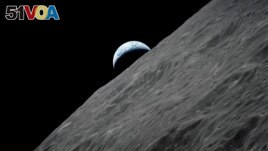Scientists say a mineral found in moon dust suggests Earth's moon is 40 million years older than scientists had believed.
The finding was made by researchers who examined moon samples gathered by astronauts from the lunar surface in 1972 – the last time humans walked on the moon. The samples were part of a collection of 110 kilograms of dust and rock returned to Earth for scientific study.
The American space agency NASA says the leading theory on how the moon formed involves a huge crash. NASA says a Mars-sized object likely crashed into Earth and released material from both objects, which formed the moon.

In this file photo, the crescent Earth rises above the lunar horizon in this undated NASA handout photograph taken from the Apollo 17 spacecraft in lunar orbit during the final lunar landing mission in the Apollo program in 1972. (REUTERS/NASA/Handout)
But the exact timing of when the moon was created has been difficult to identify. A new study based on the 1972 samples suggests the moon formed about 4.46 billion years ago.
The research was led by a team from the Field Museum of Natural History in Chicago, Illinois. The findings were recently published in a study in Geochemical Perspective Letters.
The study examined small crystals found in the lunar dust. The team said the crystals contained a mineral called zircon. The zircon is believed to have formed when the lunar surface cooled after being in a melting state after the crash.
The method used to estimate the age of the dust sample is called atom probe tomography. This method had not been developed when the sample was collected 51 years ago, said Philipp Heck. He is the lead writer of the study and the senior director of research at the Field Museum of Natural History.
NASA said the lunar sample was collected from an area known as the Taurus-Littrow valley on the near side of the moon. The near side of the moon is the side that always faces Earth. The sample had been stored at NASA's Johnson Space Center in Houston, Texas.
Heck noted that zircon is a very strong mineral that can "survive the breakdown of rocks during weathering."
The new study followed an earlier one carried out in 2021. In that study, researchers examined how many atoms of uranium and lead were contained in the zircon crystals. They then estimated the age of the mineral based on differences in the decay of the radioactive uranium to lead over time.
But the purpose of the new study was to confirm the earlier study's results, which were not considered conclusive. The examinations of the sample material were carried out atom-by-atom with very sensitive instruments, the researchers said.
Jennika Greer is a researcher in the School of Geographical and Earth Sciences at the University of Glasgow in Scotland. She helped lead the study. Greer told Reuters news agency the finding is "a great example of what the nanoscale, or even atomic scale, can tell us about big-picture questions."
Heck, from the Field Museum, said the huge crash that formed the moon was a major event that changed Earth's rotational speed. He added, "The formation date of the moon is important as only after that Earth became a habitable planet."
Greer said she hopes the team's finding can be a basis for answering many remaining questions about the moon. "It's amazing being able to have proof that the rock you're holding is the oldest bit of the Moon we've found so far." She added, "When you know how old something is, you can better understand what has happened to it in its history."
I'm Bryan Lynn.
Reuters and the Field Museum of Chicago reported on this story. Bryan Lynn adapted the reports for VOA Learning English.
_____________________________________________
Words in This Story
sample – v. a small amount of something that gives you information about the thing it was taken from
crystal –n. a mineral that has formed into a regular shape because of the physical qualities of what it is made of
decay – v. to become weak or destroyed over time, often because of natural causes like bacteria or age
conclusive – adj. proving that something is true
scale – n. the size or level of something
habitable – adj. having the ability to support life
